| Northwest of the
Gramvousa peninsula is the island of Imeri Gramvousa, where the Venetians
in the period of 1579-1584 constructed a fortress, from which they were
able to control the waters between Crete and Peloponnese.
|
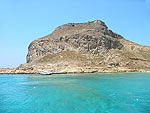
|
| The fortress was destroyed in
1588 when a lightning struck it and set its 350 barrels of gunpowder on
fire. It was rebuilt in 1630, when the Venetians felt, and with cause,
that they were threatened by the Ottoman empire, which became more and
more intrusive after the assumption of power by Murad IV.
|
| The Turks began their attack on
Crete on June 23rd 1645, when they went ashore with a big army at the
Gonia monastery near Kolimbari. In a short time they succeeded in
capturing the whole island except for Iraklion, holding out until 1669,
and the three fortresses of Gramvousa (1691), Souda and Spinalonga, not
surrendering until 1715.
|
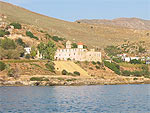
|
|
|
|
|
| After the capture of Iraklion
many partisans
(cha´nides)
fled to Gramvousa and the two other
islands. Cha´nides were Cretans hiding in the mountains,
from where they made attacks on the Turks. The attacks were often "personal"
as the Cretans wanted to revenge the attacks that the Turks had made on
their families and villages. The word cha´nides is Arabic and means
deceitful, treasonable etc. You also hear cha´nides mentioned as "kalisperides"
(= those who say good evening), because they often made their attacks in
the evenings, wishing the enemy a good evening before killing him.
|
| During the Great Greek
Revolution local Cretans tried to capture the castle on Imeri Gramvousa from the Turks, but the attempt was
doomed to failure.
|
| Because of the island's
strategic position near Peloponnese, the rebels were able to get war
materials there, and the attempt was repeated in 1825. This time they
succeeded in taking the island, and it became in this way the first area
to be liberated from the Turks. |
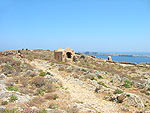
|
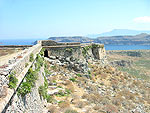 |
Shortly after 3.000 rebels went
to the island. A whole town was built with a church to Panagia Kleftrina (the
Virgin Mary, protecting the thieves), and the fortress was repaired. |
|
|
|
|
| Simultaneously an
administration council, "Kritikon Symvoulion", was established,
being the rebels' official authority. |

|
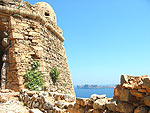 |
An unforeseen obstacle was
however, that the rebels in fact were cut off from land, so they were
forced to attack passing ships in order to get provisions. Therefore the
island soon became known as "the island of pirates", which
contributed to the turning of the political atmosphere in Europe. In
January 1828 English and French troops occupied the island, and two years
later they handed over the castle to the then Egyptian rulers of Crete,
whereupon it was abandoned. |
|
|
|
|
|
|
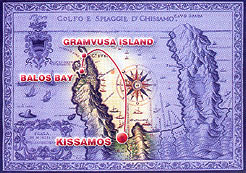
|
|
|
|
|
|
|
| The Kavonisi harbour west of
Kissamos has daily boat departures (at 10 o'clock a.m.) to Gramvousa and
further on to the picturesque beach of Balos.
|
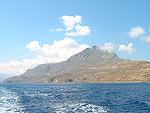 |
During the passage you may
admire the wild landscape of the Gramvousa peninsula, where the old
waterline is also very distinct. The phenomenon is due to an earthquake
about 2.000 years ago, raising Western Crete 6-9 m. |
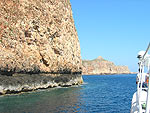
|
|
|
|
|
|
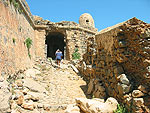 |
After an hour's sail
you arrive
at Imeri Gramvousa, where the boat pauses for 2Ż
hours, which gives you plenty of time to walk up the 137 m to the castle
by a good but steep flight of stone steps.
From here you have a magnificent view over the neighbouring island of
Agria Gramvousa, the Balos beach and the Gramvousa peninsula. |
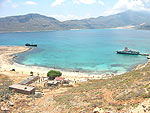
|
|
|
|
|
|
| Then
the boat continues to the Balos bay, where it anchors, and a small motor
boat takes you the last part to the beach.
|
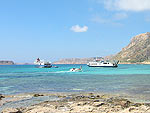
|
| About 4 o'clock p.m. the boat
returns to Kavonisi. |
|
|
|
|




